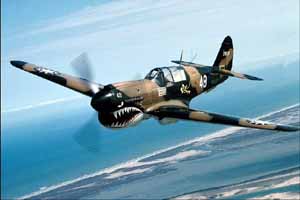Curtiss P-40N Warhawk
U.S. Fighter
 |
The Ghost Squadron's P-40N painted as an earlier version flown with the AVG "Flying Tigers" in China. Image source: The Confederate Air Force Ghost Squadron CD-ROM produced by Corel. Photos by Bill Crump. |
First flown on 14 October, 1939, the prototype XP-40 was actually the 10th production Curtiss P-36 fitted with an Allison V-12 engine in place of the P-36’s radial engine. In 1940, France ordered 140 early model P-40s, but was invaded by Germany before they aircraft could be delivered. Great Britain took delivery of the planes and named them Tomahawks.
The first production version for the USAAF was the P-40B, which had a Curtiss model number of H81-B, and deliveries began in January 1941. In mid-1941, an improved export version, the Tomahawk IIB (model H81-A2 and -A3) began to equip RAF squadrons in North Africa. One hundred planes from this batch were purchased by China and saw combat with the famed "Flying Tigers" of the American Volunteer Group (AVG) of the Chinese Air Force. Flown by about eighty American Army and Navy pilots who had been "loaned" to the Chinese as volunteers, the AVG helped protect Chinese cities and bases from Japanese bombing attacks. Although the AVG had been formed and trained while the United States was still at peace, its first combat did not take place until after the Japanese attack on Pearl Harbor. The colorful shark’s mouth painted on their P-40s, the symbol of the "Flying Tigers", was borrowed from RAF Tomahawk units.
The AVG's P-40s were similar to the USAAF's P-40C model. Armed with two .50 caliber machine guns in the nose and four .30 caliber in the wings (some AVG planes may have varied) it had a potent punch for its day. The AVG pilots quickly found that the P-40 was no match for the Japanese A6M2 Zero in maneuverability and climb rate, but using the P-40's sturdy construction, high diving speed and other tactics, quickly established superiority over the vaunted Zero.
A total of 13,738 P-40s of all models were produced during World War II, all powered by versions of the Allison water-cooled V-12 engine, except for 1,311 P-40Fs which had Packard-built versions of the Rolls-Royce Merlin V-1650, V-12 engine.
The last production version Warhawk was the P-40N, the version belonging to the CAF Ghost Squadron fleet. Many later model Warhawks were used as fighter trainers to transition pilots from the AT-6 advanced trainer. Production ended in November 1944 and a final experimental version, the XP-40Q, with a much cleaner aerodynamic form and capable of 422 mph, was never produced.
Warhawks served in most if not all theaters of World War II, and 2,097 were supplied to the USSR, as part of the Lend-Lease program.
Specifications
One Pilot One Allison V-1710-81/99 Engine Curtiss Electric Propeller Four to Six .50 caliber Machine Guns Max. Speed 378 mph @ 10,500 feet Climb to 15,000 ft in 6.7 minutes |
Length 33' 4" Max. Weight 8850 lbs Three Fuel Tanks Normal Range 575 miles |